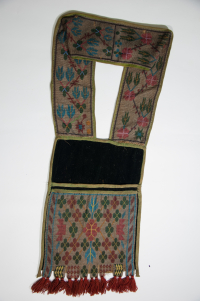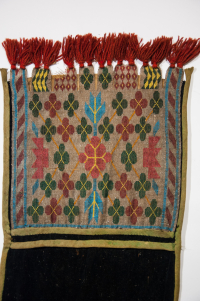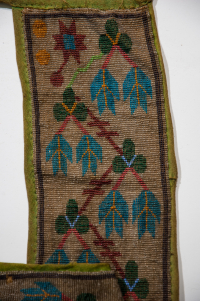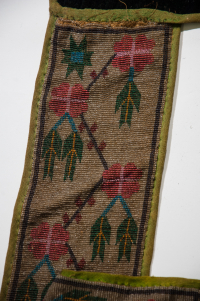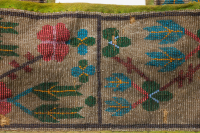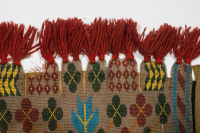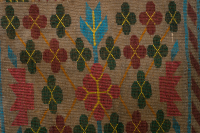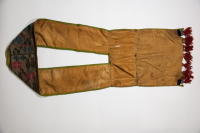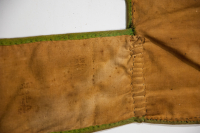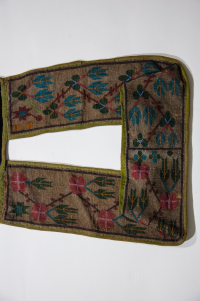Bandolier Bag
Bandolier Bag
Bandolier Bag

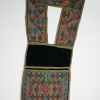
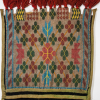
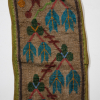
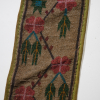
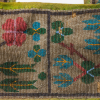
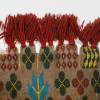
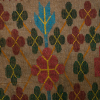
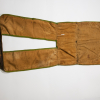

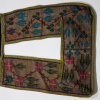
Bandolier of geometric floral loom-woven beadwork on a white field, green bias tape trim, black velveteen panel, pouch closed, 8 tabs with yarn tufts
Based on catalogue record
Read More About This Relative
Fabric: velveteen, cotton, yarn, thread, cotton, bias tape, Seed beads, glass, clear, red (transparent medium red, opaque dusty rose, opaque rose), orange (opaque yam), yellow (opaque lemon), green (transparent dark green), blue (opaque light periwinkle, opaque azure), purple (transparent dark mauve);
Hand sewn, Consists of two parts, straps and pocket, Bias tape trimming, Alternating length of tabs with double tuft red, wool yarn knotted to warp ends, Loom-woven beadwork (single warp with double weft); pouch panel sewn shut
geometric floral; teardrop; parallelogram; diamond; four petalled flower?; eight petalled flower?;
Bandolier bags most likely originated in the Upper Great Lakes region during the 1840s and 1850s. Fashioned exclusively from European materials and adorned with thousands of beads, bandolier bags were primarily for show, as a symbol of identity, wealth and status. Although initially functional, by the late 19th and early 20th centuries many of the bags had false pockets or none at all. Sometimes called "friendship bags", they were often created as gifts to strengthen relationships within communities or between nations. By the 1870s they had become an important element of formal dress worn mainly at ceremonies and celebrations by men, and occasionally by women. They wore them - singly or several at a time - crossed over the torso or draped around the neck. “The wearing of more than one bag was generally the prerogative of a leader or a person of high honour." (McCord, 2013) “Bandoliers were adopted by Ojibwa in 19th century after seeing bullet pouches used by British soldiers. Bullet pouches were plain and decorated with crest or coat of arms. When idea adopted by Ojibwa, they were greatly prized and highly decorated ceremonial accessories. They became so highly prized by Ojibwa and other tribes (especially Sioux), that one bandolier could be traded for one pony. They became a status symbol of highest ranking Midewiwin priests. (Flanders, 1977)
Provenance
Bandolier may have been acquired by Reverend Pritchard during his missions at Denorwic or Eagle Lake, Ontario or at his brother Tom's mission at Lac Seul, Ontario
McCord Museum, Wearing Our Identity. Montreal: The McCord Museum, 2013; and “Beads: Their Use By Upper Great Lakes Indians” by Richard Flanders, 1977
McCord Museum. Wearing Our Identity. Montreal: The McCord Museum, 2013. Print.
About This GRASAC Record
Manitoba Museum
Content from the Manitoba Museum's catalog records. Uploaded by Orvis Starkweather as part of their summer internship.













 Knowledge Sharing Platform
Knowledge Sharing Platform

